By Jeffrey A. Rendall; Images by Jeffrey A. Rendall and Jerry Jutras
PROVIDENCE FORGE, VA -- ‘Come to rural New Kent County, Virginia, for a taste of Ireland.’ Somehow, I doubt that’s a thought rolling through the minds of many folks, but if it finds its way into your noggin’, you’d actually be right on.
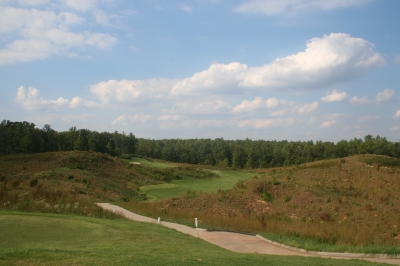 |
| The view from the tee of the par four 1st hole is one of intimidation, and sets the stage for a roller coaster of a round at Royal New Kent. |
It’s because there’s an ‘Old Country’ style links course just a few miles off of I-64 (about 25 miles west of Williamsburg), the product of the fertile imagination of the late Mike Strantz and the ownership group that conceived of the idea. And like its sister course to the east, Stonehouse, The Tradition Club at Royal New Kent’s definitely a distinctive layout in Virginia — or anywhere else in this part of the globe.
Don’t get the idea that RNK is true seaside links course, however. There are way too many trees to give it a coastal feel, and a hot, steamy Virginia summer day would remind no one of a stiff, cold breeze blowing out of the North Atlantic. There’s also a sizeable lake to the right of ten and in play on the second shot of eighteen — and that’s not the look of the Irish either (I’m told).
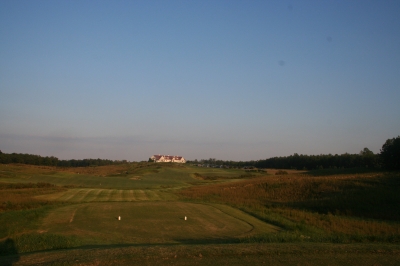 |
| Heading home on the front nine, the clubhouse serves as the backdrop to the par four 9th hole. |
But if you block out the climate changes and the water, and remove some of the deciduous forest, you’re right on the shores of Ireland (if only in your mind). Royal New Kent bills itself as a tribute to Ballybunion in Ireland and Royal County Down in Northern Ireland — and having seen neither of these courses, I can’t say whether the comparison’s an accurate one. But there’s little doubt in my mind that the same type of challenge exists at RNK that you’d find in the land of Shamrocks and Guinness.
Similar to my impressions of Stonehouse, I don’t think I’ve ever seen another course like it. Just the view off the first tee extinguishes any thoughts you might have about the nature of the course — you’re essentially hitting your tee shot in between two hills — it’s like nothing encountered in this golfing hemisphere. Some may say they’d rather not encounter it, but for those looking to challenge one of the toughest public access courses in the state, Royal New Kent’s the place.
Others have offered similar high regards of Royal New Kent. The course is only about a decade old (opened in 1998), but already has garnered a number of awards. It was voted ‘Best New Public Upscale Course in America’ by Golf Digest. Then it was named to Golf Magazine’s ‘Top 100 Courses in America’ in 1999. Royal New Kent continues to make it into various publications’ ‘top courses you can play’ lists, and Golf Digest lists it as the number three course in Virginia.
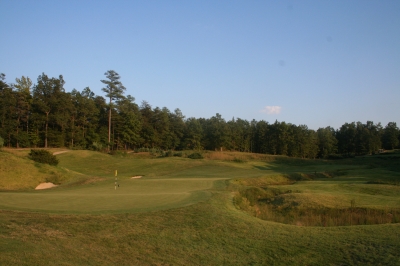 |
| Looking back at the par three 7th hole. |
Andy Bemis, General Manager and Head Pro at Royal New Kent, says his course resembles Irish layouts because it’s carved right out of the land’s natural contours. “You can tell just by looking at the shape of the course that they didn’t move much dirt when they built it. They just kind of used the lay of the land, which is pretty nice — and it’s one of the reasons why the course is severe in spots. But all in all, the property’s natural ebb and flow really adds to the layout.”
“Strantz was able to effectively shape the holes because of the sheer size of the property. Because he wasn’t forced to put golf holes within certain boundaries, he could place them where they seemed to fit naturally into the surrounding environment. The result speaks for itself — you’ve got a lot of unique looking shot values, a real visual experience,” Bemis added.
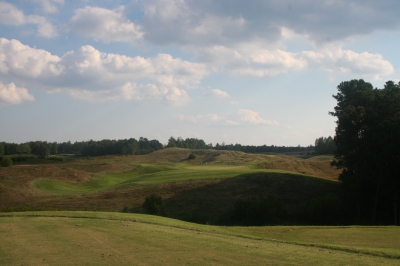 |
| Just about every tee shot at Royal New Kent requires a carry. Here, the 191-yard, par three 3rd hole. |
That’s the truth. Royal New Kent is a visual masterpiece. When it first opened, it felt like it was in the middle of nowhere, a strange slice of Irish links golf in the golfing twilight zone. Now that there are houses going in at certain points in the course, it’s lost some of its rural quality, but you’ll still feel a sense of isolation while playing it.
As to what would possess someone to place this type of course in this location, Bemis said the original owners (the Legends Group of Myrtle Beach, SC) loved links golf in Scotland and Ireland – and somehow they saw Ireland in this part of rural Virginia. Mike Strantz was just the choice to design it, as his knack for ‘quirks’ would fit right in.
That’s not to say Royal New Kent is quirky. Personally, I hated it the first time I played it, mostly because I didn’t understand it. Once you’ve played it more than a couple times, you’ll understand where you need to place the ball and discover that the course is really pretty forgiving on most shots unless you miss badly.
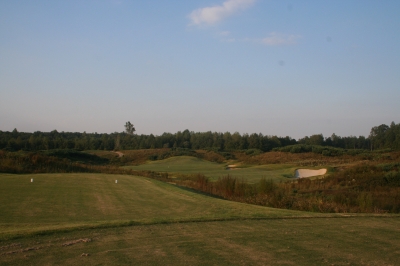 |
| The par four 8th hole isn't long (418 yards), but if your tee ball isn't positioned perfectly in the fairway, you won't be able to see the green tucked in amongst mounds. |
It helps that they’ve softened the layout considerably since it first opened. Areas that used to be tall grass have been mowed so that you’ve at least got a chance to find the ball and play it – whereas in the old days, if you were slightly off, you were gone.
Bemis echoes my comments about the need to play the course several times to appreciate it: “When people leave here, I want them to say ‘I can’t wait to come back and play this one again.’ No matter how many times you play Royal New Kent, you will learn something new with every round.”
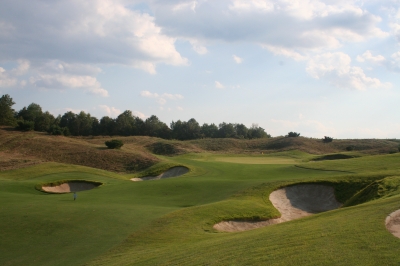 |
| Looking towards the green of the par four 4th hole. Like a true Irish links course, you'll need to position your ball in the right spots to avoid hazards. |
One more thing about RNK -- you’ll get to see a lot of it. Something characteristic and different about both RNK and Stonehouse are the cart path rides. Sometimes, it seems like there’s a half-mile in between holes, but the ride adds a certain quality to the outing that you won’t get at more traditional courses (walking is allowed, but not encouraged because of this). That’s not always a good thing — mostly because it guarantees a long round. But if you’re not in any hurry -- play your game, pay close attention to the yardage book, follow the signs and enjoy the ride. The scenery is very beautiful.
And while the course is incredibly difficult from the back sets of tees, the forward sets make it much more player-friendly — because you’re able to club-down from the tee boxes. Again, like Stonehouse, the fairways are quite generous (average over 40 yards wide). Bemis says the second shots are really where the challenge comes into play at RNK, and I’d agree, because the putting surfaces are heavily guarded — by bunkers, streams, or steep slopes. If you miss on the approach, you’ll pay.
“The challenge at Royal New Kent is in course management,” Bemis said. “You have to think your way around and play shots that are within your ability. If you try to hit the perfect shot and don’t pull it off, the layout will punish you.”
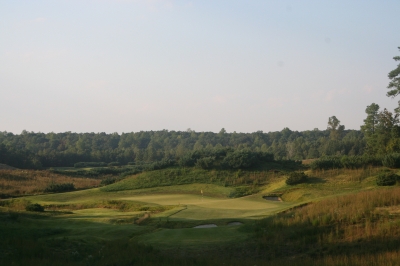 |
| The landscape of the par three 7th hole demonstrates why Mike Strantz decided to emulate an Irish links course. Rolling hills, striking topography. |
Special kudos are given to the course conditions, especially the greens. In one word, pristine. They’re huge (some of the biggest I’ve ever seen), but they roll extremely well, and you won’t find better putting surfaces anywhere in terms of quality and true reads.
If you’ve ever dreamed of figuring out the line on a 30 yard putt, then calculate the speed, here’s your chance. The twelfth hole’s green is 86 yards long. Yes, eighty-six yards. By my calculations, that’s about seven clubs long right there. ‘Hmmm, should I take a nine iron or a three iron?’ It’s never boring at Royal New Kent.
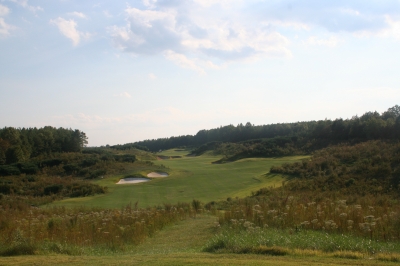 |
| The par five 5th hole is long (590 yards) and difficult. The tee shot is relatively easy, but then you'll have to think to play the balance of the hole. |
Looking at some of the holes, starting off, you’re faced with the aforementioned tee shot — squeeze it in between two hills. Long hitters can try and carry the hill on the left, which would cut the dogleg off quite a bit (the second shot’s to an elevated green), but you’ll also need to carry a depression to reach the fairway if you choose that route. First-timers beware. The smart play is to the wide fairway, but will add 40 or 50 yards to the approach shot.
The fifth hole is worthy of special note. It’s the toughest hole on one of the toughest courses in the state. Again, the tee shot’s not that difficult. But on the second, you’ll have to hit it high as well as long, or there’re tall bunkers and grasses encroaching on the fairway. The massive green is also well protected, mandating precise third shots — with tricky fast contours.
Seven is a great par three. 186 yards from the gold tees, you’ll need to carry a stream that guards the entire left side, and avoid a pair of bunkers long. Club selection is crucial, as the hole plays downhill and you’ll almost always have a breeze to contend with. A back left pin placement is extremely difficult.
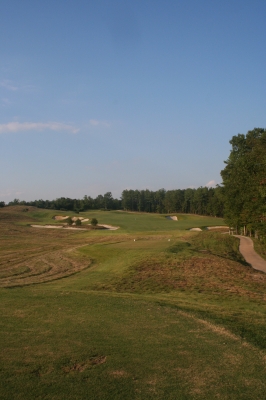 |
| You can't tell it from this view, but the green of the par four 6th hole is one of the more unique putting surfaces you're ever going to see. One word: slope. |
The backside starts with an incredible par five. Tee shots must carry a set of bunkers and stay to the left of a stand of trees that could interfere with second shots. Not really reachable in two, so second shots must carry a large sandy waste area to set up a short iron to the green. The putting surface is practically surrounded by steep bunkers, so hit the target if you want anything close to par.
Fourteen’s a unique hole. There’s a downhill tee shot, with a wide fairway fronted by large hills to the left and right, about driver distance away. It’s possible to try and hit the narrow neck in between the hills, but it’ll still leave a shot in to an elevated green. Smart play is a long iron or five-wood off the tee, which leaves a short iron up over the hills to the huge green. Fun hole.
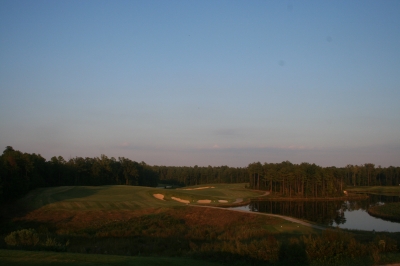 |
| The par five 10th hole is a masterpiece of a hole, requiring length and accuracy to play it well. |
Eighteen is the only hole where a lake comes into play. Tee shots must fly it, but it’s only about 150 yards of carry, even from the back tees. The fairway is extremely wide, setting up the challenging final approach to the round. The green is surrounded on three sides by the lake (which curls around the wide fairway), so choose carefully the mid to short iron you’ll use to stay dry.
When the final putt rolls in, several thoughts come to mind. First, you’re invigorated. Second, you’re exhausted. Third, you’ll be proud you met the challenge. Finally, you might feel lucky — fortunate even. Fortunate, because there’ll always be another chance to try out this intriguing layout once again. And maybe next time you won’t need the luck of the Irish to score well.
Details:
The Tradition Golf Club at Royal New
Course Designer: Mike Strantz
General Manager/Head Pro: Andy Bemis
Phone: (804) 966-7023; (888) 765-5550
Website: http://www.traditionalclubs.com/view.asp?id=356&page=9230
Tees/Yardage/Slope/Rating
Invicta 7336 76.5/147
Gold 6965 74.9/144
Black 6560 73.1/141
White 6023 70.8/135
Green 4971 72.0/130 (L)
Rates:
Royal New Kent offers an attractive membership package for local residents, which you can use with the other Tradition Clubs in the area, Kiskiack and Stonehouse.
Rack rates vary from $45-$99, depending on the season.
| Related Links | Comments on this article? | |
|
Maryland National Golf Club Hollow Creek Golf Club Rocky Gap Resort PB Dye Golf Club in Ijamsville Whiskey Creek Golf Club |
E-mail Jeff Rendall, Editor: jrendall@golftheunitedstates.com |











